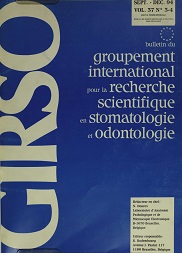Dental pulp in the field of DNA fingerprints
Keywords:
DNA, alleles, identification, toothAbstract
Blood, hairs and sperm are tissues currently used in Forensic Science to carry out DNA fingerprints in the field of individual identification. Our study aims at showing that dental pulp can also be an exploitable DNA source.
A quantitative and qualitative DNA investigation on a yield gel with sizing extracted from this tissue shows that the molecule appears to be in a great quantity and of a high molecular weight. The last characteristic allows the use of the restriction fragments lenght polymorphic technique to make DNA fingerprints, based on the individual variations of the restriction sites disposition, within the DNA molecule, for a given enzyme.
Thus, for an enzyme, the lenght of the restriction fragments obtained and revealed by a probe, is visualized by autoradiograph.
According to this technique, we compared the DNA fingerprints obtained on 8 persons with the probe MS43A, from both pulpar and nucleated blood cells.
During the extraction of the third molar of each sample, a small quantity of blood was taken in the tooth socket. In the same time DNA was recovered.
For a same person, the autoradiograph showed the same pattern for both blood and toogth sample.
The DNA profile similitude confirms the possibility of using the tooth for genetic analysis. The interest in using dental tissues as a DNA source of individual identification falls within the particular character of resistance of this organ towards physical or chemical exterior agressions.
The tooth which until now was used in Anthropology and Forensic Science for its morphological aspects could be used this way for genetic study.
Downloads
Published
Issue
Section
License
I hereby certify that the authors of the above manuscript have all:
1. Conceived, planned, and performed the work leading to the report, or interpreted the evidence presented, or both;
2. Written the report or reviewed successive versions and shared in their revisions; and
3. Approved the final version.
Further, I certify that:
1. This work has not been published elsewhere and is not under revision in another journal;
2. Humane procedures have been followed in the treatment of experimental animals (if applicable);
3. Investigations in humans was done in accordance with the ethical standards of the responsible committee on human experimentation or with the Helsinki Declaration (if applicable).
4. This paper has been carefully read by a native English speaker who is familiar with the field of work (this applies to authors who are not fluent in English); and
5. The copyright of the article is transferred from the authors to the Bulletin du Groupement International pour la Recherche Scientifique en Stomatologie et Odontologie upon acceptance of the manuscript.



